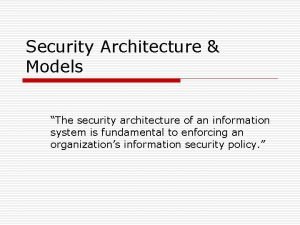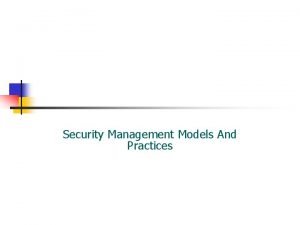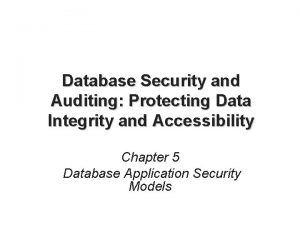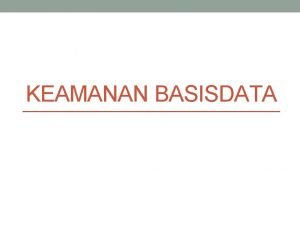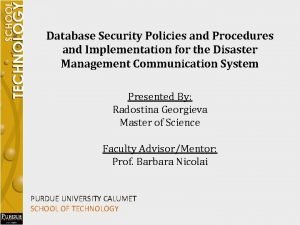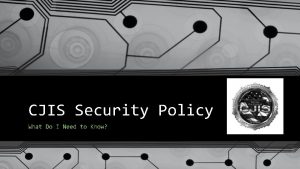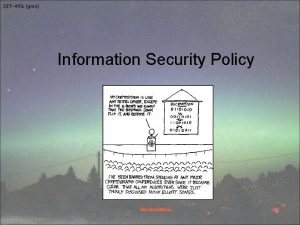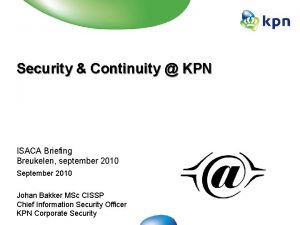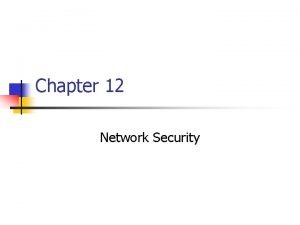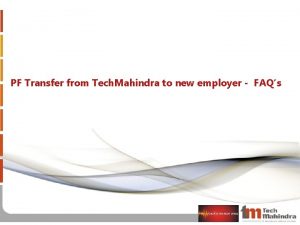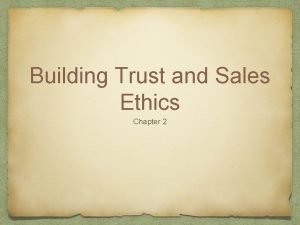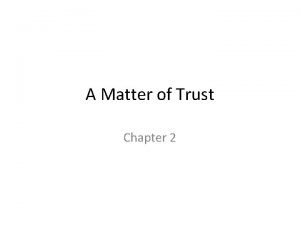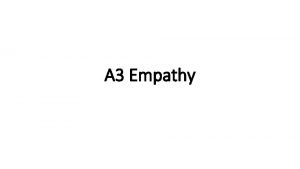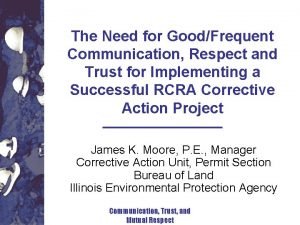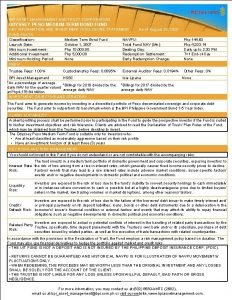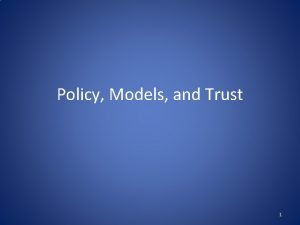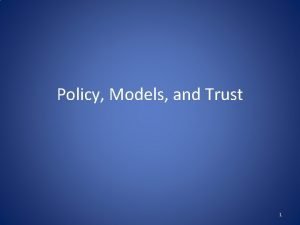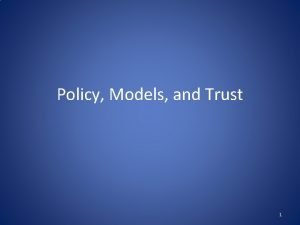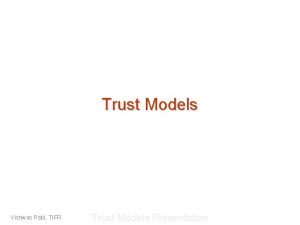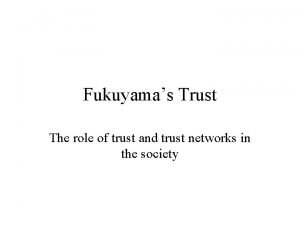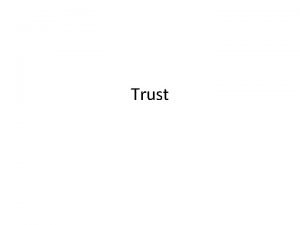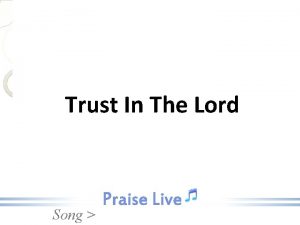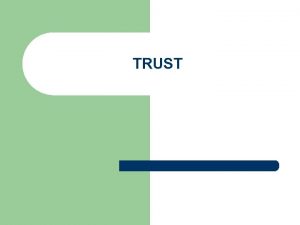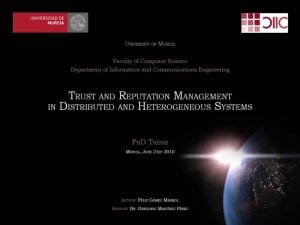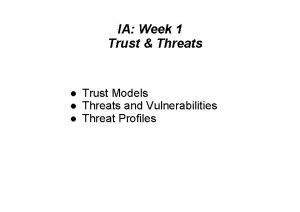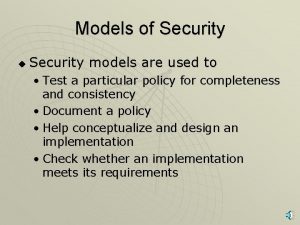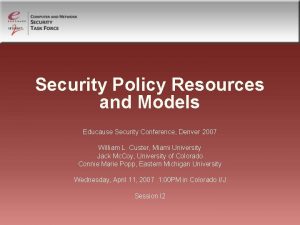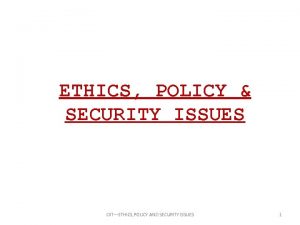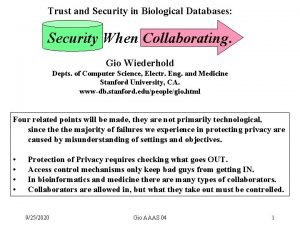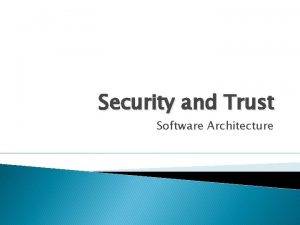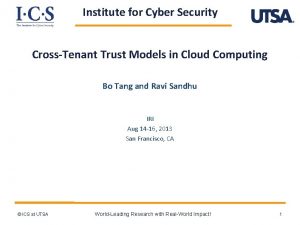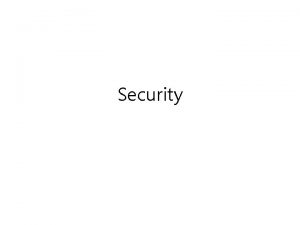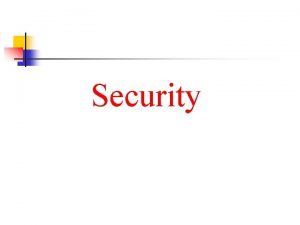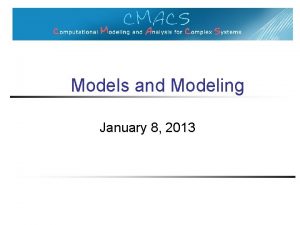Policy Models and Trust 1 Security Policy A





































- Slides: 37

Policy, Models, and Trust 1

Security Policy • A security policy is a well-defined set of rules that include the following: • Subjects • Objects • Actions • Permissions • Protections 2

Security Policy • Subjects: the agents who interact with the system, which could be defined in terms of specific individuals or in terms of roles or ranks that groups of individuals might hold within an organization. – Individuals could be identified by their names or by their job titles, like President, CEO, or CFO. Groups could be defined using terms such as users, administrators, generals, majors, faculty, deans, managers, and administrative assistants. This category also includes outsiders, such as attackers and guests. 3

Security Policy • Objects: the informational and computational resources that a security policy is designed to protect and manage. – Examples include critical documents, files, and databases, and computational resources include servers, workstations, and software. 4

Security Policy • Actions: the things that subjects may or may not do with respect to the objects. – Examples include the reading and writing of documents, updating software on a web server, and accessing the contents of a database. 5

Security Policy • Permissions: mappings between subjects, actions, and objects, which clearly state what kinds of actions are allowed or disallowed. • Protections: the specific security features or rules that are included in the policy to help achieve particular security goals, such as confidentiality, integrity, availability, or anonymity. 6

Security Models • A security model is an abstraction that provides a conceptual language for administrators to specify security policies. • Typically, security models define hierarchies of access or modification rights that members of an organization can have, so that subjects in an organization can easily be granted specific rights based on the position of these rights in the hierarchy. • Examples include military classifications of access rights for documents based on concepts like “unclassified, ” “confidential, ” “secret, ” and “top secret. ” U. S. government image in the public domain. 7

Discretionary Access Control • Discretionary access control, or DAC, refers to a scheme where users are given the ability to determine the permissions governing access to their own files. – DAC typically features the concept of both users and groups, and allows users to set accesscontrol measures in terms of these categories. – In addition, DAC schemes allow users to grant privileges on resources to other users on the same system. 8

Mandatory Access Control • Mandatory access control is a more restrictive scheme that does not allow users to define permissions on files, regardless of ownership. Instead, security decisions are made by a central policy administrator. – Each security rule consists of a subject, which represents the party attempting to gain access, an object, referring to the resource being accessed, and a series of permissions that define the extent to which that resource can be accessed. • Security-Enhanced Linux (SELinux) incorporates mandatory access control. 9

Access Control • Discretionary access control – An object may be copied – Owner of new object is whoever created it – So he who copies owns the copy – Owner gets to decide access rights • Mandatory access control – While an object may be copied – Objects have labels that specify access – Organization decides access rights: global policy 10

Trust Management • A trust management system is a formal framework for specifying security policy in a precise language, which is usually a type of logic or programming language, together with a mechanism for ensuring that the specified policy is enforced. • A trust management system consists of two main components: – a policy language – a compliance checker • Policy rules are specified in the policy language and are enforced by the compliance checker. 11

Trust Management Systems • A trust management system typically has rules describing: • Actions: operations with securityrelated consequences on the system • Principals: users, processes, or other entities that can perform actions on the system • Policies: precisely written rules that govern which principals are authorized to perform which actions • Credentials: digitally signed documents that bind principal identities to allowable actions, including the authority to allow principals to delegate authority to other principals. 12

Access Control Models • Various models have been developed to formalize mechanisms to protect the confidentiality and integrity of documents stored in a computer system. – The Bell-La Padula (BLP) model – The Biba model – The Low-Watermark model – The Clark-Wilson model – The Chinese Wall model (The Brewer and Nash model) 13

The Bell-La Padula Model • The Bell-La Padula (BLP) model is a classic mandatory access-control model for protecting confidentiality. • The BLP model is derived from the military multilevel security paradigm, which has been traditionally used in military organizations for document classification and personnel clearance. 14

The Bell-La Padula Model • BLP is an information flow model • Lattice-based security • Objects and subjects have security labels – Object: classification – Subject: clearance 15

The Bell-La Padula Model • The BLP model has a strict, linear ordering on the security of levels of documents, so that each document has a specific security level in this ordering and each user is assigned a strict level of access that allows them to view all documents with the corresponding level of security or below. 16

Total Orders and Partial Orders • A linear ordering for documents can be defined in terms of a comparison rule, . We say that such a rule defines a total order on a universe set, U, if it satisfies the following properties: 1. Reflexivity: If x is in U, then x < x. 2. Antisymmetry: If x < y and y < x, then x = y. 3. Transitivity: If x < y and y < z, then x < z. 4. Totality: If x and y are in U, then x < y or y < x. • All of the usual definitions of “less than or equal to” for numbers, such as integers and real numbers, are total orders. • If we drop the requirement of totality, we get a partial order. – The classic example of a partial order is the set of courses taught at a college or university, where we say that, for two courses A and B, A < B, if A is a prerequisite for B. 17

The Rest of BLP • Labels have two components: 1. Level 2. Need-to-know compartment • Level is linear (total) order • Compartment is a set, with set partial order – Set C < C’ iff C is contained in C’ • Domination of labels – Label (L, C) >= (L, C’) iff L >= L’ and C’ <= C 18

How the BLP Model Works • The security labels in BLP form a partial order, <. • Each object, x, is assigned to a security label, L(x). Similarly, each user, u, is assigned to a security label, L(u). Access to objects by users is controlled by the following two rules: – Simple security property. A user u can read an object x only if L(x) < L(u). – *-property. A user u can write (create, edit, or append to) an object x only if L(u) < L(x). • The simple security property is also called the “no read up” rule, as it prevents users from viewing objects with security levels higher than their own. • The *-property is also called the “no write down” rule. It is meant to prevent propagation of information to users with a lower security level. 19

Defining Security Levels Using Categories 20

The Biba Model • The Biba model has a similar structure to the BLP model, but it addresses integrity rather than confidentiality. • Objects and users are assigned integrity levels that form a partial order, similar to the BLP model. • The integrity levels in the Biba model indicate degrees of trustworthiness, or accuracy, for objects and users, rather than levels for determining confidentiality. – For example, a file stored on a machine in a closely monitored data center would be assigned a higher integrity level than a file stored on a laptop. – In general, a data-center computer is less likely to be compromised than a random laptop computer. Likewise, when it comes to users, a senior employee with years of experience would have a higher integrity level than an intern. 21

The Biba Model Rules • The access-control rules for Biba are the reverse of those for BLP. That is, Biba does not allow reading from lower levels and writing to upper levels. • If we let I(u) denote the integrity label of a user u and I(x) denote the integrity label for an object, x, we have the following rules in the Biba model: – A user u can read an object x only if I(u) < I(x). – A user u can write (create, edit or append to) an object x only if I(x) < I(u). • Thus, the Biba rules express the principle that information can only flow down, going from higher integrity levels to lower integrity levels. 22

The Low-Watermark Model • The low-watermark model is an extension to the Biba model that relaxes the “no read down” restriction, but is otherwise similar to the Biba model. • In other words, users with higher integrity levels can read objects with lower integrity levels. • After such a reading, the user performing the reading is demoted such that his integrity level matches that of the read object. 23

Label Float, Trusted Subjects • What happens when a write is requested in BLP to an object with lower label than subject? – Either deny write, or – Increase label of object to that of subject • This results in “Label Float” in which all objects gradually move towards system high labels! • Also – need for “trusted subject” in both models – Downgrade/declassify objects – Aggregate unreliable information 24

The Clark-Wilson Model • Rather than dealing with document confidentiality and/or integrity, the Clark-Wilson (CW) model deals with systems that perform transactions. • It describes mechanisms for assuring that the integrity of such a system is preserved across the execution of a transaction. Key components of the CW model include the following: – Integrity constraints – Certification methods – Separation of Duty (SOD) 25

The Clark-Wilson Model • Integrity constraints – express relationships among objects that must be satisfied for the system state to be valid. A classic example of an integrity constraint is the relationship stating that the final balance of a bank account after a withdrawal transaction must be equal to the initial balance minus the amount withdrawn. 26

The Clark-Wilson Model • Certification methods – verify that transactions meet given integrity constraints. Once the program for a transaction is certified, the integrity constraints do not need to be verified at each execution of the transaction. 27

The Clark-Wilson Model • Separation of duty rules – prevent a user that executes transaction from certifying it. In general, each transaction is assigned disjoint sets of users that can certify and execute it, respectively. 28

Role-Based Access Control • The role-based access control (RBAC) model can be viewed as an evolution of the notion of group-based permissions in file systems. U. S. Navy image in the public domain. 29

Role-Based Access Control • An RBAC system is defined with respect to an organization, such as company, a set of resources, such as documents, print services, and network services, and a set of users, such as employees, suppliers, and customers. U. S. Navy image in the public domain. 30

RBAC Components • • User Role Permission Session 31

RBAC Components • A user is an entity that wishes to access resources of the organization to perform a task. Usually, users are actual human users, but a user can also be a machine or application. 32

RBAC Components • A role is defined as a collection of users with similar functions and responsibilities in the organization. Examples of roles in a university may include “student, ” “alum, ” “faculty, ” “dean, ” “staff, ” and “contractor. ” In general, a user may have multiple roles. – Roles and their functions are often specified in the written documents of the organization. – The assignment of users to roles follows resolutions by the organization, such as employment actions (e. g. , hiring and resignation) and academic actions (e. g. , admission and graduation). 33

RBAC Components • A permission describes an allowed method of access to a resource. – More specifically, a permission consists of an operation performed on an object, such as “read a file” or “open a network connection. ” Each role has an associated set of permissions. 34

RBAC Components • A session consists of the activation of a subset of the roles of a user for the purpose of performing a certain task. – For example, a laptop user may create a session with the administrator role to install a new program. – Sessions support the principle of least privilege. – Session is bound to role(s) according to binding permissions of user and user requests. 35

Hierarchical RBAC • In the role-based access control model, roles can be structured in a hierarchy similar to an organization chart. • More formally, we define a partial order among roles by saying that a role R 1 inherits role R 2, which is denoted R 1 > R 2, if R 1 includes all permissions of R 2 and R 2 includes all users of R 1. • When R 1 > R 2, we also say that role R 1 is senior to role R 2 and that role R 2 is junior to role R 1. – For example, in a company, the role “manager” inherits the role “employee” and the role “vice president” inherits the role “manager. ” – Also, in a university, the roles “undergraduate student” and “graduate student” inherit the role “student. ” 36

Visualizing Role Hierarchy 37
 Electronic commerce security
Electronic commerce security Private secruity
Private secruity What is the difference between model and semi modal
What is the difference between model and semi modal Northern trust charitable trust
Northern trust charitable trust Microsoft from back doors patch gov
Microsoft from back doors patch gov Security architecture models
Security architecture models Security management model
Security management model Multilevel security model
Multilevel security model Database security models
Database security models Infosec management models
Infosec management models Wireless security in cryptography and network security
Wireless security in cryptography and network security Level 3 cjis security test
Level 3 cjis security test Osi security architecture model with neat diagram
Osi security architecture model with neat diagram Security guide to network security fundamentals
Security guide to network security fundamentals Visa international security model
Visa international security model Electronic mail security in network security
Electronic mail security in network security Cnss model
Cnss model Seven touchpoints for software security
Seven touchpoints for software security Security guide to network security fundamentals
Security guide to network security fundamentals Security guide to network security fundamentals
Security guide to network security fundamentals Kebijakan keamanan
Kebijakan keamanan Keamanan basis data
Keamanan basis data Database security policies
Database security policies Fbi cjis security policy
Fbi cjis security policy Xkcd specifications
Xkcd specifications Kpn security policy
Kpn security policy Palo alto panorama demo
Palo alto panorama demo Security policy cycle
Security policy cycle Tech mahindra establishment id
Tech mahindra establishment id Building trust and sales ethics
Building trust and sales ethics A matter of trust book summary
A matter of trust book summary Johannes volkelt empathy theory examples
Johannes volkelt empathy theory examples Uhcw library
Uhcw library Trust communication respect
Trust communication respect Duty of trust and confidence cipd
Duty of trust and confidence cipd Care and share charitable trust
Care and share charitable trust Bpi asset management
Bpi asset management Some may trust in horses
Some may trust in horses





